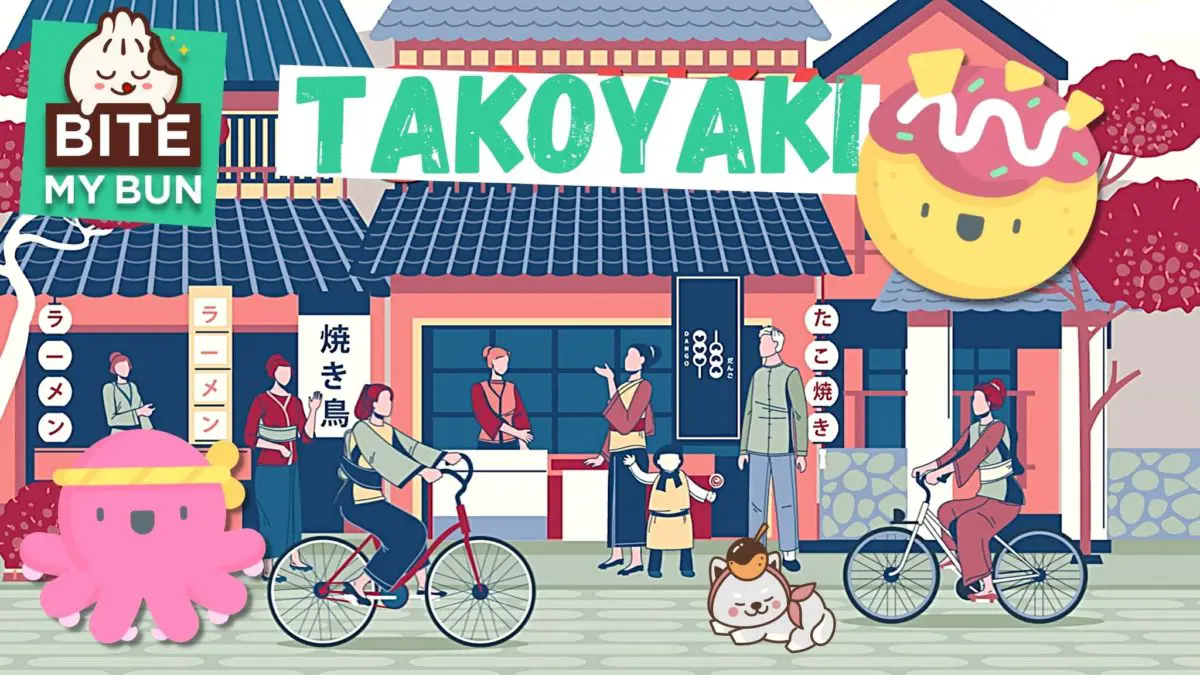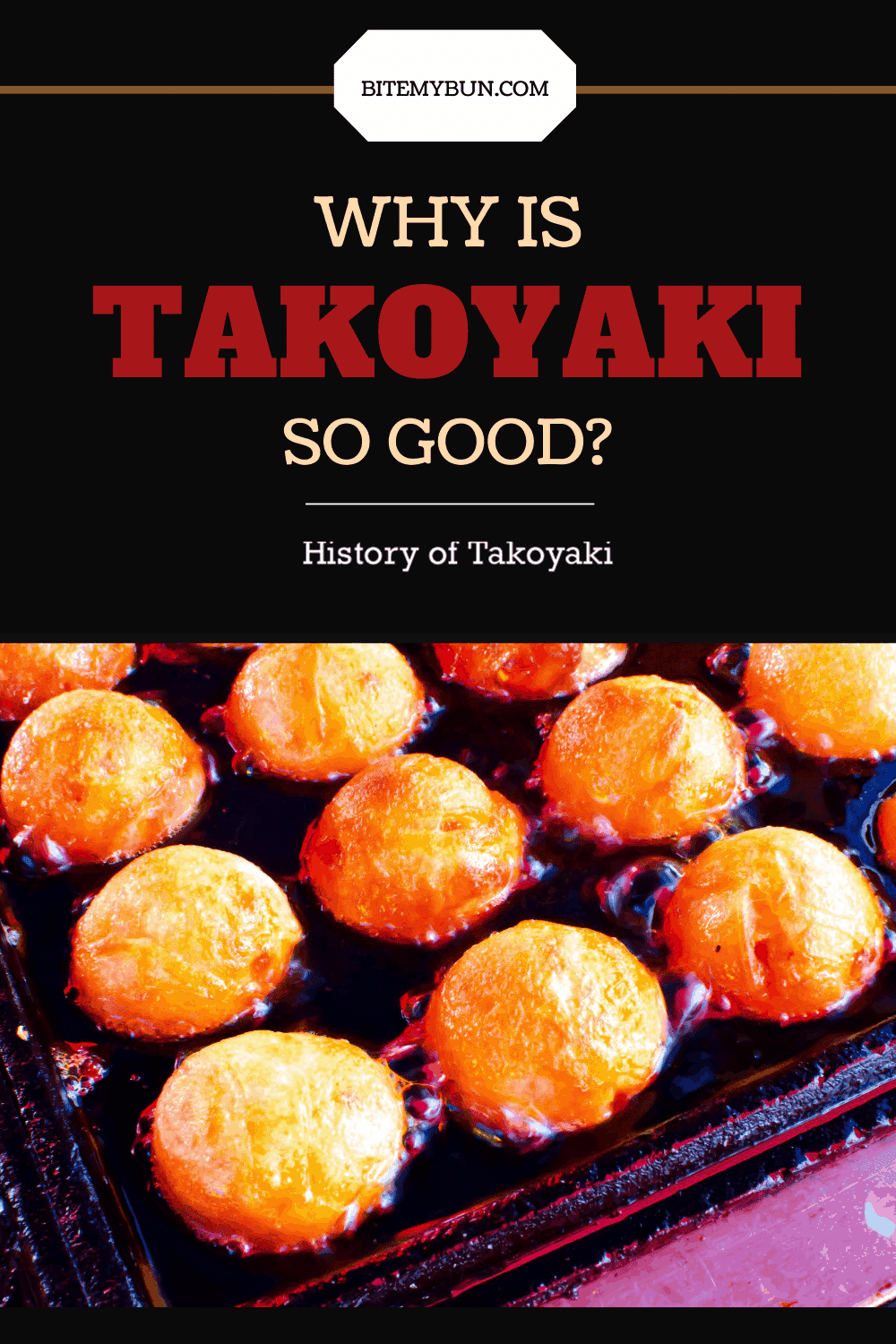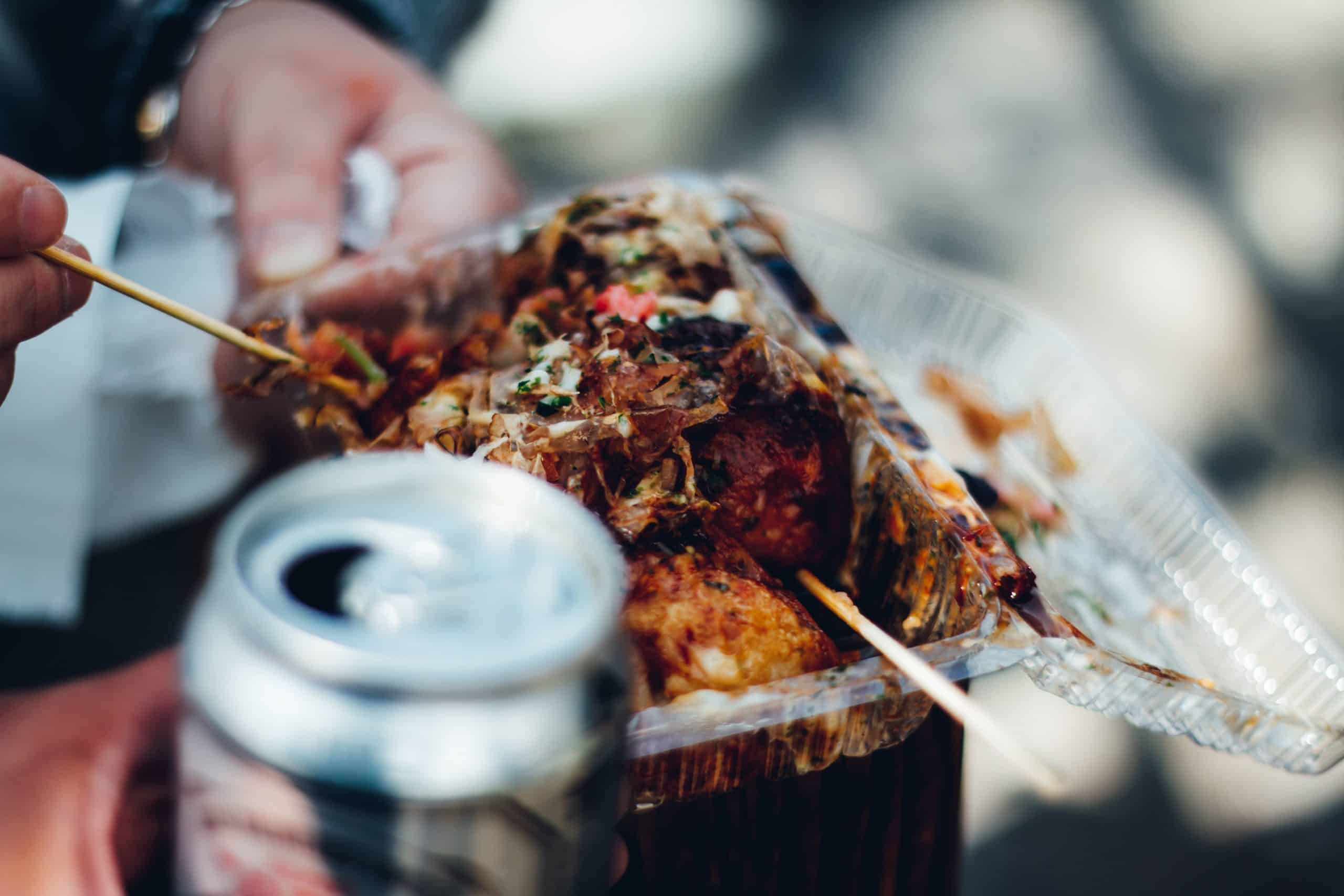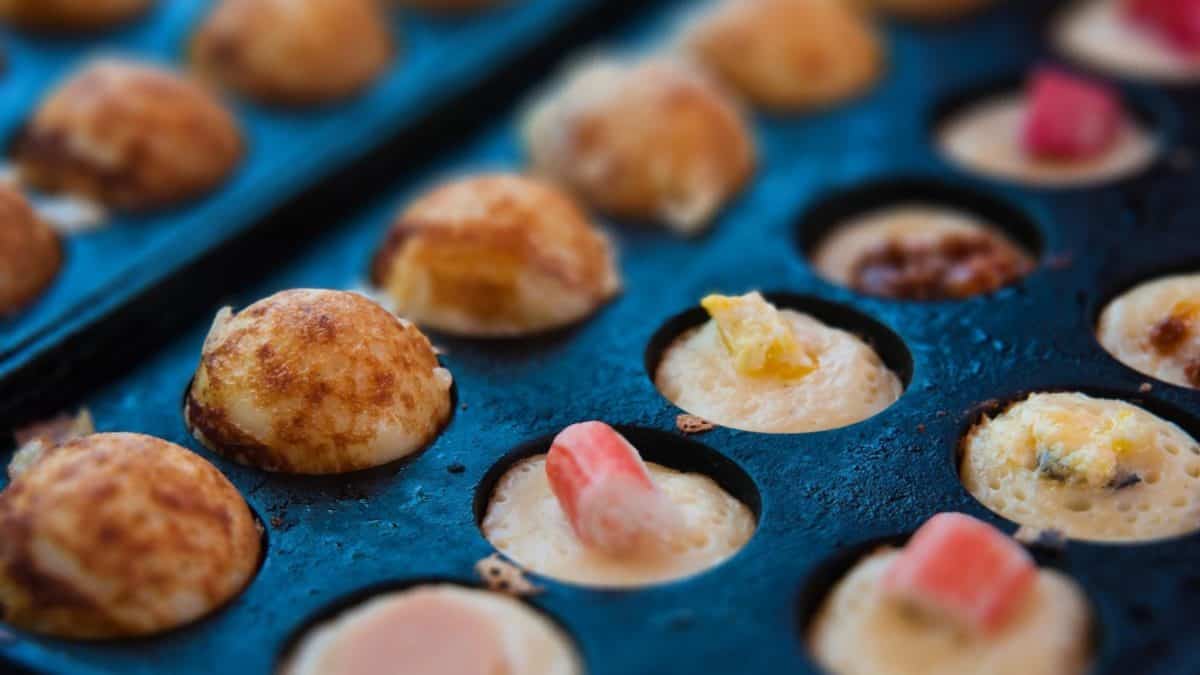What is Takoyaki? Octopus Balls Street Food
What is takoyaki?
Takoyaki are balls made from wheat flour with octopus (tako) inside. It’s a street food from Japan that’s fried (yaki) in a special pan made exclusively for the dish. They were invented in 1935 in Osaka by the street vendor Tomekichi Endo.
If you were to translate it into English directly, it would be “octopus grill” because tako means octopus and yaki “to grill”.
Tomekichi didn’t create a revolutionary dish of his own, but he took a more simplistic and flavorful take on Choboyaki. Soon enough, all of Japan was raving over Osaka’s new popular food.

Eventually, all of Japan was made aware of a street vendor in Osaka’s ingenious street food invention.

Check out our new cookbook
Bitemybun's family recipes with complete meal planner and recipe guide.
Try it out for free with Kindle Unlimited:
Read for freeIn this post we'll cover:
What is takoyaki?
Takoyaki is a popular Japanese snack or appetizer. It’s made from a wheat-based batter and cooked in a specially molded pan.
These spherical molds form the batter into balls during the frying process. The result is a set of ball-shaped snacks you can easily eat on the go.
Takoyaki is a form of konamono since wheat-based food is called konamono in Japan.
Why is it called octopus balls?
Takoyaki are often called octopus balls because of the ingredients. They’re ball-shaped and usually filled with diced or minced octopus. Tako means octopus in Japanese. So, they’re not the balls of an octopus, but balls that are filled with octopus meat.
What are the takoyaki fillings?
Takoyaki is filled with tako (baby octopus) along with tenkasu (tempura scraps), pickled ginger, and green onion. Every household and vendor has its variant, but these are the basic ingredients.
Read here about buying ingredients and utensils for takoyaki
What are the most used takoyaki toppings?
The balls are brushed with takoyaki sauce, which is similar to Worcestershire sauce, and Japanese mayonnaise (the kewpie mayo has slightly different ingredients than American).
The dumpling is then cooked in a special pan known as the Takoyaki pan and served with Takoyaki sauce on top.
Takoyaki has multiple toppings to serve as you can see in this authentic recipe here, including katsuobushi, takoyaki sauce, and Japanese mayo. Sometimes, people also sprinkle some bits of chili flakes or powder to add spiciness to the food.
What does takoyaki taste like?
Takoyaki has a soft texture and is very moist. You would feel like it melts inside your mouth as you chew. This salty snack has a savory oceanic flavor coming from the chewy octopus inside of it. You will notice a hint of kelp flavor from the dashi on the ball batter. The toppings enhance the complexity of its taste.
The flavor of this dish is considered “umami” or savory. The taste is salty and rich, due to the seafood flavors of the octopus.
As a rule of thumb, if you like how octopus tastes, most likely you will love takoyaki.
Is takoyaki a snack or a meal?
While this dish is considered a snack, it can be enjoyed as a meal because it’s very filling and it contains different food groups like wheat from the dough, protein from the octopus and fish, and vegetables from the beni shoga and seaweed. It’s not considered a whole dinner though.
Is takoyaki comfort food?
Yes, takoyaki is often considered comfort food. Comfort foods evoke a sense of nostalgia, warmth, and satisfaction. Takoyaki, with its warm, savory, and slightly crispy texture and flavors from the batter and various fillings, fits this description for many people.
Is takoyaki an appetizer?
Takoyaki is not considered an appetizer. Throughout Japan, it’s a common snack, sold at various street food vendors. Takoyaki pairs well with alcoholic beverages like beer, and various types of Japanese drinks. So, you could technically call it pub food, in the same category as yaki onigiri (grilled riceballs).
In the Osaka region (but not only), you will also find takoyaki served at festivals and celebrations, again as a grab-n-go snack. People eat it from a little takeout container with a toothpick.
Octopus balls are made with a batter that contains quite a lot of carbs, and they are also deep-fried in oil, these takoyaki snacks aren’t very healthy, and that’s why Japanese people don’t eat takoyaki as a meal.
Now, for you to understand its taste, I’ll give you a bit more background information on this snack.
Where can you find takoyaki in Japan?
People in Japan were raving about Takoyaki! So much so that today you can expect to find Takoyaki not just at festivals but in convenience stores, fine dining, and even in many households.
Takoyaki is a popular form of Japanese treat, commonly found (or most popularly found), in food stalls during summer festivals, especially in Osaka.
As Japan’s number one street food, you would be able to find them easily from street vendors with stalls called yatai.
They are also widely available in traditional markets and festivals. If you are fond of Japanese cuisine, takoyaki must be on your try list.
To eat the takoyaki, hold the toothpicks the same way you hold chopsticks. But instead of tweezing the food with them, you spear it with them.
Vendors serve takoyaki right away after it is taken out of the stove because all the taste and aroma will gradually fade as the dish cools off. Hence, be careful not to burn your mouth.
History of takoyaki: is takoyaki from Japan?

What was the precursor of takoyaki?
The precursor of takoyaki is called choboyaki. Choboyaki was a more rectangular, flat, and less flavorful dish than the new takoyaki invention that Tomekichi created.
Choboyaki was made by pouring a batter made of flour and water into semi-spherical molds on a copper or cast-iron griddle.
The batter was accompanied by red pickled ginger, konjac, onions, and shoyu. The mixture was then grilled to perfection, resulting in delectable dumplings.
Takoyaki was originally from Osaka, circa 1935. The octopus fried ball is a transformation of what used to be called choboyaki. Choboyaki has similar ingredients as takoyaki.
A man by the name of Tomekichi Endo invented the takoyaki and popularized it in Osaka in 1935. He is a street vendor but was quite the smart cook.
But instead of a round ball, choboyaki was more like a flat square. Another difference is the filling, as choboyaki uses beef instead of octopus.
Choboyaki then evolved to rajioyaki, the very same food but with a ball shape like today’s takoyaki.
People still use beef as fillings, although it was not so long before people started switching it with octopus. This marked the birth of takoyaki.
This street snack gained its popularity real fast due to the unique octopus flavor. The chewy texture and light flavor of the briny meat makes a wonderful complement with the dashi and toppings.
People also try out many other things to use as fillings, but the name Takoyaki remains.
You can have the ball snack filled with shrimp, cheese, or tofu (for vegan option). Yet still, up until now, the most popular version is the octopus.
The takoyaki konamono derived from akashiyaki, which is a small spherical dumpling (made of an egg-rich batter and octopus) that originated from Akashi City in Hyōgo Prefecture.

With a new taste hitting the streets of Akashi City, so too its popularity started spreading across various regions which included Kansai, Kanto as well as the rest of the country as time went on.
It is believed that the first takoyaki snacks were introduced among the yatai street food stalls, which later evolved into takoyaki specialty restaurants, which are widespread across the Kansai region.
Today takoyaki has gained so much notoriety that it has become a household name in Japan. It is also sold at commercial outlets like 24-hour convenience stores and supermarkets.
The takoyaki dish is also very popular in Taiwan. Historically, the island nation is a common trading partner of Japan since ancient times. It has borrowed some Japanese cuisines and adopted them into their culture such as the takoyaki.
The oldest known takoyaki store is Aizuya in Osaka and was founded by the cuisine’s inventor himself, Tomakichi Endo in the 1930s. The store has remained operational to this day.
Before the takoyaki became famous for its octopus meat as one of its base ingredients, Endo first experimented with beef and konjac and improved the flavorings for the batter too!
Nicknamed as the “octopus balls”, the takoyaki was first known by that name before it was called takoyaki today. It became widespread across Japan as it was among the favorite in the classic Japanese street food stalls dipped in brown sauce.
Takoyaki in Osaka
Although Takoyaki has now been widely popular and available throughout Japan, you still need to go to Osaka if you aim for an ultimate culinary adventure with these fried balls.
The town has more than 650 takoyaki stores, with subtle taste differences between one to another.
While most people serve takoyaki with multiple toppings, in Osaka you will see some takoyaki is garnished only with a pinch of salt to highlight the strong dashi flavor in the batter.
Another variation of a takoyaki is takosen, which is two takoyaki balls sandwiched between two crackers.
What makes takoyaki so popular?
Taste is one of the major reasons why food becomes famous. However, it goes beyond taste in the case of takoyaki.
Many consider takoyaki to be soul food. They claim that once eaten, it can stimulate a person’s taste buds to the extent that it touches the deepest part of a person’s heart.
You’ll crave more after taking your first bite!
Also, takoyaki is full of “umami,” a popular Japanese flavor. Many say that this flavor has majorly contributed to takoyaki as soul food, so long as you like eating tentacles, as well as other flavors derived from the sea.
Besides the numerous flavors that can be added to this dish, it can make someone cry because of the scale of its deliciousness.
Takoyaki pan: what is it & where did it come from?
A takoyaki pan is a cast-iron griddle with half-spherical or round molds where you place the dough and cook it. The pan heats up evenly and cooks the takoyaki balls until golden brown. The spherical design is what makes the takoyaki round.
You need to flip the balls while cooking because the pan only browns the bottom of the dough.

Takoyaki octopus balls aren’t really fun to make without using a special cast iron takoyaki pan (I’ve reviewed them here).
The takoyaki pan is called a takoyaki-nabe, a cast iron griddle that’s dotted with indented half-spherical molds.
The unique iron griddle heats up the takoyaki evenly until the bottom half-spherical side of it cooks. Then the ball is turned over using a special pick or a larger bamboo skewer (you know, the ones they use for yakitori as well).
This allows the uncooked batter to cook in the base of the rounded cavity. It’s kind of like deep-frying but with every ball in its own little shallow pocket of oil.
During open-air Japanese festivals, restaurants, street vendors, or individuals use LPG or LNG tanks.
You can also get smaller electric versions that look a bit like a hotplate to use at home, and you even have some smaller cast iron makers for your stovetop.
Because takoyaki is a fairly easy recipe to cook and is quite the popular street food in Japan, so many households in Japan own a takoyaki pan.
It’s also the reason why the production and sale of this particular kitchen item are common in Japanese stores and supermarkets. However, they may not be as popular outside of Japan.
Takoyaki pans are similar to:
- dutch “poffertjes” pans that also cook batter in individual holes.
- Another option is to look for the Danish aebleskiver pan which can also be used to make takoyaki (here’s how).
Check out our new cookbook
Bitemybun's family recipes with complete meal planner and recipe guide.
Try it out for free with Kindle Unlimited:
Read for freeJoost Nusselder, the founder of Bite My Bun is a content marketer, dad and loves trying out new food with Japanese food at the heart of his passion, and together with his team he's been creating in-depth blog articles since 2016 to help loyal readers with recipes and cooking tips.
